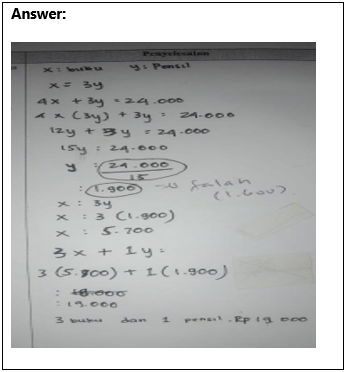Analysis of Problem-Solving Ability of Junior High School Students in A System of Linear Equations With One Variable
Main Article Content
Abstract
This research is motivated by the low ability of students to solve mathematical problems, which is reflected in the results of surveys and previous research. Even though mathematics is considered an important subject, many students still experience difficulties in understanding and solving mathematical problems, including solving problems with systems of linear equations in one variable. The research method used is descriptive with a quantitative approach. This research aims to describe and analyze students' problem solving abilities. The subjects used were 30 selected class VIII students at Al-Faruqi Middle School. Data was collected through tests, then analyzed to identify student errors in solving problems on systems of linear equations in one variable. The results of the research show that the majority of students experience difficulty in understanding basic concepts, are less thorough in the problem solving process, have difficulty understanding problem questions, and have difficulty allocating time when working on questions. Based on data analysis, the percentage of student errors is classified as moderate. From these results, it is concluded that further efforts are still needed to improve students' mathematical problem solving abilities, especially in the context of one-variable linear equation systems. This can be done by focusing more on identifying factors that cause student errors and developing learning strategies that are more effective in improving students' understanding and problem solving skills in mathematics.
Article Details

This work is licensed under a Creative Commons Attribution 4.0 International License.
References
Adhalia, Dhesy, And Nancy Susianna. 2021. "Problem Solving, Creative Thinking, and Reasoning Skills in Learning Mathematics Using Visual Media." Polyglot: Scientific Journal 17(1): 101. Doi:10.19166/Pji.V17i1.2636.
Aida, N., Kusaeri, K., & Hamdani, S. (2017). Characteristics of the Cognitive Domain Mathematics Learning Outcome Assessment Instrument Developed Referring to the Pisa Model. Suska Journal of Mathematics Education , 3 (2), 130. https://doi.org/10.24014/sjme.v3i2.3897
Andayani, Fitrie, And Adiska Nadiyah Lathifah. 2019. "Analysis of Middle School Students' Problem Solving Abilities in Solving Questions on Social Arithmetic Material." Scholar's Journal : Journal of Mathematics Education 3(1): 1–10. Doi:10.31004/Cendekia.V3i1.78.
Angraeni, Dina, And Polya's Steps. 2022. "Analysis of Students' Mathematical Problem Solving Ability in Linear Equations with One Variable for Class 7 Middle School." 2(2):1–8.
Dwi Putra, H., Fathia Thahiram, N., Ganiati, M., Nuryana, D., Studi, P., Mathematics, P., Siliwangi, I., Jenderal, JT, Cimahi, S., Kunci, K. , Solving, K., Mathematical, M., & Student, P. (2018). Middle School Students' Mathematical Problem Solving Ability in Building Materials. Development of Project-Based Blended Learning Model to Support Student Creativity in Designing Mathematics Learning in Elementary School. Scientific Journal of Mathematics Education) , 6 (2), 82–90. http://journal.unipma.ac.id/index.php/jipm
Handayani, Sri, And Dadang Rahman Munandar. 2023. "Analysis of Class VIII Middle School Students' Mathematical Problem Solving Ability on Algebra Material." Journal of Syntax Transformation 4(2): 183–91. Doi:10.46799/Jst.V4i2.689.
Hidayat, Rahmat, Eva Yanti Siregar, and Rahmatica Elindra. 2022. "Analysis of the Factors of the Low Mathematical Problem Solving Ability of Students at the Padangsidimpuan Taruna Private Vocational School." Mathedu (Mathematic Education Journal) 5(3): 114–20. Http://Journal.Ipts.Ac.Id/Index.Php/ .
Husna, N., & Munawarah, M. (2018). Application of the Problem Solving Learning Model to Improve Students' Mathematical Communication Skills in Middle School. Variables , 1 (1), 36. https://doi.org/10.26737/var.v1i1.575
Kushendri. Zanthy, LS (2019). Analysis of Junior High School Students' Mathematical Problem Solving Ability on SPLDV Material . 01 (03), 438–447.
Kusuma, MD, Rosidin, U., Abdurrahman, A., & Suyatna, A. (2017). The Development of Higher Order Thinking Skill (Hots) Instrument Assessment in Physics Study. IOSR Journal of Research & Method in Education (IOSRJRME) , 07 (01), 26–32. https://doi.org/10.9790/7388-0701052632
Lestari, Kameswari Sri, Siti Nurjanah, And Luvy Sylviana Zanthy. 2019. "Analysis of Comprehension Ability and Bandung on Linear Equation One Material." 2(3): 107–18.
Malasari, PN, Herman, T., & Jupri, A. (2017, September). The construction of mathematical literacy problems for geometry. In Journal of Physics: Conference Series (Vol. 895, No. 1, p. 012071). IOP Publishing.
Mariam, S., Nurmala, N., Nurdianti, D., Rustyani, N., Desi, A., & Hidayat, W. (2019). Analysis of mtsn students' mathematical problem solving abilities using the open ended method in West Bandung. Scholar's Journal: Journal of Mathematics Education, 3 (1), 178-186.
Martin, Tandililing, E., & Yani, A. (2018). Middle School Students' Mathematical Understanding and Problem Solving Ability Through Problem-Based Learning Models. Journal of Education and Learning , 7 (1), 1–19.
Meika, I., Ramadina, I., Sujana, A., & Mauladaniyati, R. (2021). Students' mathematical problem solving abilities using the SSCS learning model. Scholar's Journal: Journal of Mathematics Education , 5 (1), 383-390.
Minarni, A., and Napitupulu, E.E. (2017). Developing Instruction Materials Based On Joyful Pbl To Improve Students Mathematical Representation Ability. International Education Studies . Vol. 10 No. 9, Issn. 1913-9020, Pp 23-39
Nurfauziah, N., & Zanthy, LS (2019). Analysis of junior high school students' mathematical problem solving abilities on integer material. Journal on Education , 1 (2), 215-228.
Putra, HD, Putri, WAS, Fitriana, U., & Andayani, F. (2018). Mathematical Problem Solving Ability and Self-Confidence of Middle School Students. SJME (Supremum Journal of Mathematics Education) , 2 (2), 60-70.
Rambe, AYF, & Afri, LD (2020). Analysis of Students' Mathematical Problem Solving Ability in Solving Problems on Sequences and Series Material. AXIOM: Journal of Education and Mathematics , 9 (2), 175. https://doi.org/10.30821/axiom.v9i2.8069
Shufriyah, N., SUNISMI, S., & EL WALIDA, SIKKY (2020). Problem Solving Ability Through the Role Learning Model Reviewed by Emotional Intelligence Material on Linear Equations and Inequalities with One Variable for Class VII Students. Journal of Research, Education and Learning , 15 (18).
Widada, W, Nugroho, KUZ, Sari, WP, & Pambudi, GA (2019). The ability of mathematical representation through realistic mathematics learning based on ethnomathematics. Journal of Physics: Conference Series , 1318 (012073), 1–8. https://doi.org/10.1088/1742-6596/1318/1/012073
Yuliani, SR, Setiawan, W., & Hendriana, H. (2019). Analysis of Junior High School Students' Errors in Comparative Material in View of Mathematical Problem Solving Ability Indicators. Journal On Education , 01 (02), 77–82.
